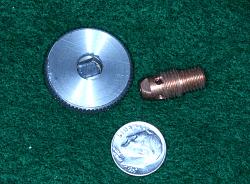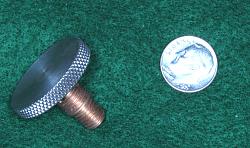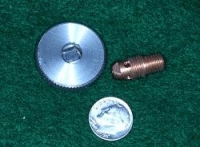Was putzing with my aenomometer project today. I’ve been gonna make an aenomometer (wind speed meter) for years, decided to finally get around to it this coming shop season. It’ll mount to the flag pole at the lake, be solar-powered with a radio link to the cabin.
Such things are readily available as weather instruments for under $50 but what fun is that? I contemplate a rotating cup Robinson anemometer like the weather bureau uses:
I have three hemispherical aluminum cups that I bought years ago in contemplation of such a project. I think they’re meant to be welded atop fence posts. I recently bought some ceramic ball bearings from EBay; ceramic so they won’t rust when out in weather. They’re used in skateboards and fidget spinners so they’re quite inexpensive but actually pretty good bearings.
I’ll need to weld some aluminum rods to the cups. Since I have only three cups I would rather not screw one of them up, so I decided to do a bit of practice welding of aluminum. I don’t do it every day so a bit of practice never hurts to “get the knack back” on scrap bits. I tried both oxyacetylene brazing and TIG welding. Haven’t decided which way I’ll go yet, probably TIG. I have Allstate #31 aluminum brazing rod and some stuff from The Tin Man (www.tinmantech.com) that works well but I'm concerned about minimizing heat distortion and maintaining balance. With TIG I can do autogenous welds (no added filler metal).
While setting up my TIG torch for aluminum (it had been set for steel) I had to change tungsten electrodes. I’ve found that 2% lanthanated tungstens work better for DC welding of steel, while 0.8% zirconiated tungstens work better for AC welding of aluminum. Conventional wisdom is to use pure tungsten for AC welding of aluminum, with the tip shaped to a ball. My skilled mentor (Jay) said, “yeah, Foreman, and since when do you worry about being conventional? Forget that ********, listen to me: use a rare-earth doped electrode ground to a very fine point. It will shape itself to the right configuration in about 3 seconds on whatever job you’re doing at the heat setting you’re using. You’ll have to re-grind for every new setup, but you’ll have to do that anyway because a klutz like you will certainly dunk the electrode in the puddle at least once and need to snap off and regrind.”
Right on all counts, Jay!
Lanthanium, zirconium and thorium are rare-earth elements used to dope welding tungstens to improve their electric arc behavior. I don’t use thoriated tungstens anymore because the lanthanated and zirconiated jobs work better for me – and oh, by the way, thorium is mildly radioactive so the dust produced when grinding thoriated tungstens is carcinogenic. I think a guy would have to be grinding tungstens 40 hours a week to be at risk so I never worried about that, but I prefer the other flavors because they work better for me.
Hokay, so I was changing the collets on the torch because I’d changed tungsten sizes; I reached for the vise grips to tighten the piece into the torch.
“Foreman”, I thought, “you have been doing that far too long. Make a proper wrench fachrissakes, today, RFN!” I know better to disagree with my stubborn self so I said, “yeah, OK, sure Foreman, right now yoo betcha.” Foreman said, “and skip the brownnosing.” “Screw you, Foreman.” “That’s more like it.”
The flats on the copper tips measure .223” across flats, no standard dimension either metric or imperial that I know of other than it is the caliber of standard M4 and M16 military rifles. But OK, I can make it whatever, it ain’t rocket parts.
The tips don’t need to be torqued in with any notable force; they just need to be snug enough to stay put. I decided that a knurled disc would work well, and it’d fit in one of the little square compartments of the little tackle box where I keep the tips, collets and ceramic gas cups for the TIG torch all organized and tidy.
I milled a .225” slot in the end of a piece of .312” dia mild steel rod stock. The .225 is not a typo, I purposely left a coupla thou of clearance. Wrenches should fit fairly closely but they need not be precision fits. Then I made a knurled steel disc in the lathe, about 1” dia and about 0.200” thick with a .3125” diameter hole drilled and reamed in it. Then I silver-brazed the bit of slotted rod into the hole. Then I wrapped the knurled assembly in a skinny strip of thin aluminum roof flashing to protect the knurls, grabbed that in the lathe chuck and machined off the excess part of the rod. The copper part in the photos is the nosepiece of the TIG torch; they are consumables and I have several for each size of tungsten.

I’ve never seen a tool like this in a welding store but it certainly works a treat. It’ll be right there in the little tackle box of TIG torch parts whenever I need to change tungstens. I’ll grin every time I use it, pretty much every time I fire up the TIG welder.


 LinkBack URL
LinkBack URL About LinkBacks
About LinkBacks




 Reply With Quote
Reply With Quote



Bookmarks